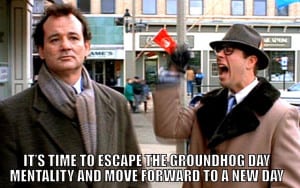 In commemoration of this month’s Groundhog Day, I wanted to offer all those marketers who – like Bill Murray – feel stuck in the same situation over and over and over and hope or wish for some clarity on how to get it right.
In commemoration of this month’s Groundhog Day, I wanted to offer all those marketers who – like Bill Murray – feel stuck in the same situation over and over and over and hope or wish for some clarity on how to get it right.
The notion that, as marketers, we need to get the right message to the right person at the right time has been played over and again like a bad movie (not to insinuate Groundhog Day is anything less than a classic). We’ve all heard it a thousand times. Over and over again. This message is so tired, not because it isn’t true, but because the ability to execute on this mandate feels so out of reach.
The key that I would offer marketers to sending the right message to the right person at the right time is simply… context. It starts with two simple questions: Who is the right person? And what is the message they need? Who and what – two simple words – but once identified, provides all the context needed.
Long before digital marketing, the question of ‘who’ someone was to a brand was used by marketers. In the print age, recency, frequency and monetary (RFM) analysis of a customer base was the norm for marketers and dictated which customers received print pieces, while the more sophisticated organizations armed their sales staff with elite customer lists enabling added attention to those high lifetime value (LTV) shoppers.
Ironically, as marketers moved into the digital space, the basic concept of ‘who’ was largely discarded from the digital marketer’s vernacular. Instead the focus turned towards open rates, click-throughs, and the holy grail – conversions! But over the last few years, RFM has been re-introduced as a new generation of marketers are exposed to this age-old concept with an understanding that identifying ‘who’ their shoppers are could be used for segmentation to drive better results. Unfortunately, identifying and understanding ‘who’ is as reliable as Punxsutawney Phil’s prediction that there are still six weeks left of winter – although as I currently look out my window to see a wintery landscape, I fear Phil may be correct on this one.
Because of the ambiguous methodology around identifying ‘who’ in the age of digital, digital marketers instead turned to ‘what’ to determine messaging strategies. All messaging channels such as email, display, and onsite content have been tuned towards which products a shopper added to their cart or viewed on the website. This proves to be an effective approach for marketers as this strategy does drive a lot of revenue. However, this approach over time has diminishing returns and doesn’t get to the heart of understanding your customer needs.
Finally, much like the warm beaches that I just left in Miami at the Email Experience Council are relief from the weekly blizzards I experience in Indianapolis – customer intelligence that allows for insightful data are the salvation for marketers that allows them to move from an antiquated and limited-view of ‘who’ to an understanding of customers in ways never before available. Marketers can begin to identify the repeat visitor who consistently enters through paid acquisition channels, the low average order value but high margin customer; a highly-engaged shopper who has never made a purchase, and so much more. This important use of customer intelligence transforms not only a marketer’s ability to determine ‘who’, but in doing so more strategically determine the ‘what’ so that you can have the right conversation with your customers.
Combining this new insight of the customer with the types of behavioral triggers previously used (and hundreds of untapped new ones) can, and should, alter the entire customer experience your visitors have … which results in more loyal customer and revenue in the long run.
The days of batch and blast are over! And I’m not talking about just email – but for all digital channels. Because the good news is … it’s incredibly simple to begin building these customer profiles today. You just need the right technology to feed in all of your data points that allow you to build customer intelligence that works for your organization – whatever your goals may be. It becomes a simple matter of strategy and execution.
It’s time to escape the Groundhog Day mentality and move forward to a new day. And clearly, by the looks of things, it’s achievable since… we’re already past February 2nd.
Jason Fordham is the Vice President of Strategic Solutions at SmarterHQ, a customer intelligence and cross-channel marketing platform.